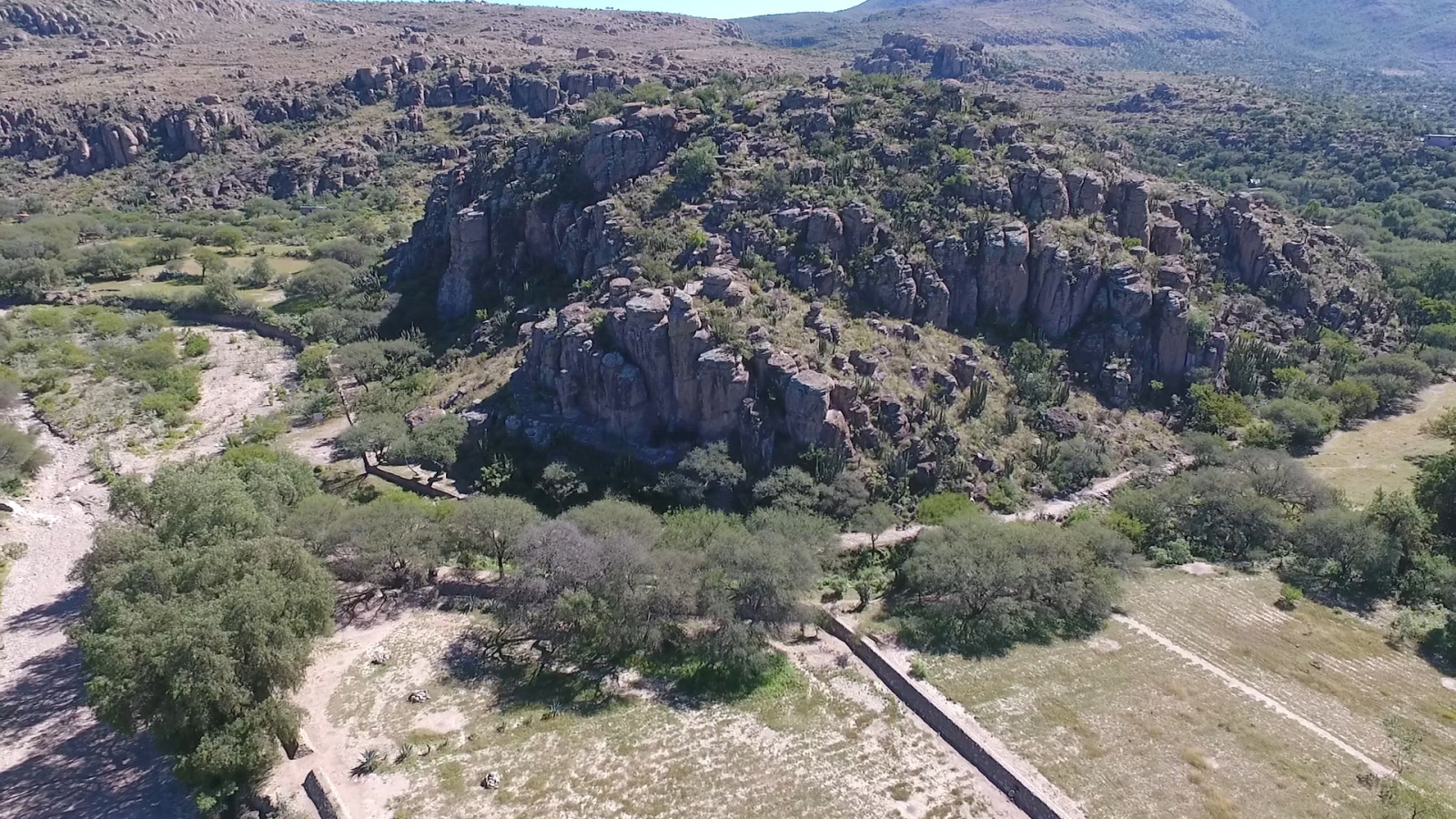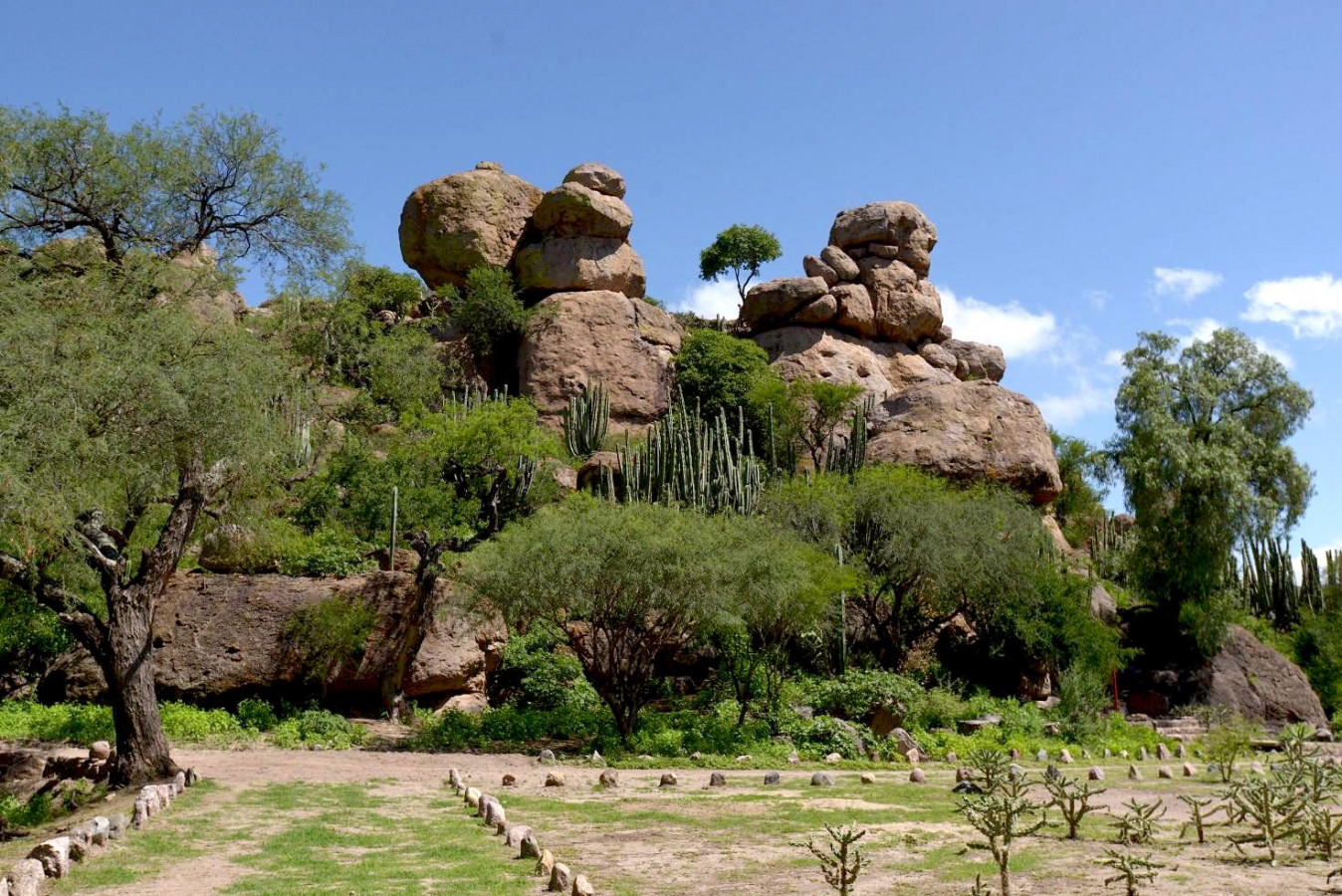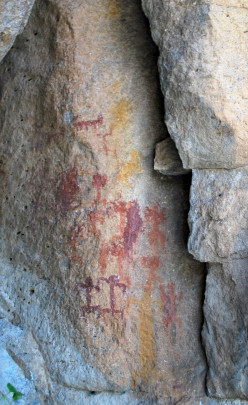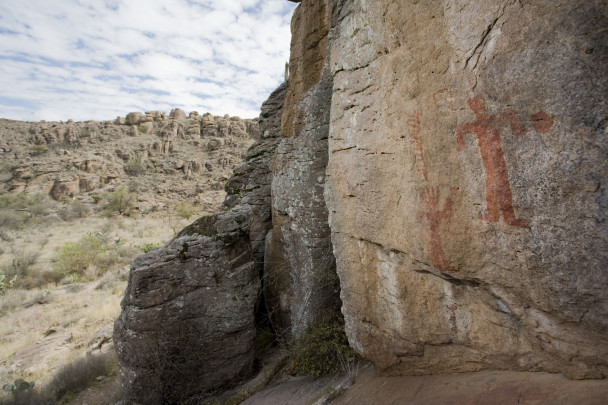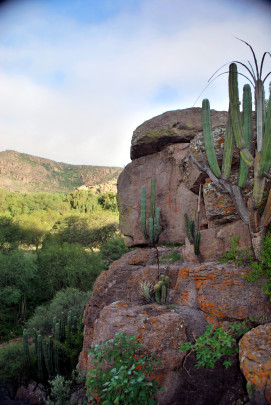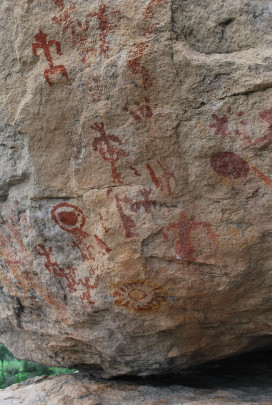Arroyo seco
Arroyo Seco is one of the most representative rock art sites in the north-east of Guanajuato state. The imagery, created above all by hunter-gatherer societies during the pre-Hispanic period, constitutes one of the most emblematic such examples from central and northern region of Mexico.
About the site
Arroyo Seco is located 2.5 kilometers to the south-east of the town of Victoria, at the heart of a small fertile valley crossed by a riverbed that is dry most of the year. The hills surrounding this valley are formed of soft tuff, which the action of wind and water has eroded into a landscape with singular characteristics: capricious columns like extravagant stone sculptures on which the pictorial motifs were painted. The sheer number and variety of images drawn on the rocks makes this place a veritable synthesis of the region’s rock art. Together, the art and the surrounding landscape offer an example of how the ancient hunter-gatherer peoples who lived in the north-east of Guanajuato state saw and understood the world.
The site’s various rock supports comprise 46 pictorial groupings together with hundreds of motifs that are distributed over two small elevations known as La Zorra and La Pintada (or La Tortuga). The distribution of the pictorial motifs responds to factors closely related to the worldview, ritual and identity of the indigenous societies who inhabited this territory during the pre-Hispanic and Colonial periods. It is therefore of note that the painted panels on the hill of La Zorra are oriented towards the setting sun, while those on La Pintada or La Tortuga face the rising sun. Meanwhile, we may appreciate that a characteristic of the rock art of Arroyo Seco was an obsession with representing the human form, something shared with the whole region. However, there are also animal, plant and geometric forms.
The region’s rock art was already known of in the sixteenth century, as the priest Guillermo de Santa María made reference to an enigmatic place located somewhere near Sichú (San Juan Bautista Xichú de Indios, today known as Victoria) and Los Samúes (Mineral Real de San Francisco de los Amues/Sichú, now Xichú), simply called the “Painted Caves” which appears to refer to the large number of rock art sites in Victoria, including Arroyo Seco. In 2005 the Rock Art project began in the Victoria river basin, focused on researching the region’s rock art and the conservation of the Arroyo Seco site. In 2010, with the intention of protecting it and opening it up to the public, the site became part of the management plan promoted as part of the Fideicomiso de Administración de Inversión para la Realización de las Actividades de Rescate y Conservación de Sitios Arqueológicos (FIARCA), with federal support from the National Institute of Anthropology and History, and of the state government through the State Culture Institute and the municipality of Victoria. It was opened in March 2018.
The site’s various rock supports comprise 46 pictorial groupings together with hundreds of motifs that are distributed over two small elevations known as La Zorra and La Pintada (or La Tortuga). The distribution of the pictorial motifs responds to factors closely related to the worldview, ritual and identity of the indigenous societies who inhabited this territory during the pre-Hispanic and Colonial periods. It is therefore of note that the painted panels on the hill of La Zorra are oriented towards the setting sun, while those on La Pintada or La Tortuga face the rising sun. Meanwhile, we may appreciate that a characteristic of the rock art of Arroyo Seco was an obsession with representing the human form, something shared with the whole region. However, there are also animal, plant and geometric forms.
The region’s rock art was already known of in the sixteenth century, as the priest Guillermo de Santa María made reference to an enigmatic place located somewhere near Sichú (San Juan Bautista Xichú de Indios, today known as Victoria) and Los Samúes (Mineral Real de San Francisco de los Amues/Sichú, now Xichú), simply called the “Painted Caves” which appears to refer to the large number of rock art sites in Victoria, including Arroyo Seco. In 2005 the Rock Art project began in the Victoria river basin, focused on researching the region’s rock art and the conservation of the Arroyo Seco site. In 2010, with the intention of protecting it and opening it up to the public, the site became part of the management plan promoted as part of the Fideicomiso de Administración de Inversión para la Realización de las Actividades de Rescate y Conservación de Sitios Arqueológicos (FIARCA), with federal support from the National Institute of Anthropology and History, and of the state government through the State Culture Institute and the municipality of Victoria. It was opened in March 2018.
Did you know...
• The north-east of Guanajuato state concentrates the largest number of rock art sites in northern Mexico.
• The style of the pictorial motifs at Arroyo Seco belongs to the Painted Tradition of Semi-arid Mexico, which is found in northern Michoacán, Querétaro, Guanajuato, southern San Luis Potosí, Aguascalientes and southern Zacatecas.
• A range of minerals were used to make the paints, such as hematite for red, goethite for yellow, charcoal for black, and calcite and dolomite for white.
• The chromatic palette of the rock paintings at Arroyo Seco includes at least 15 shades of red.
• The style of the pictorial motifs at Arroyo Seco belongs to the Painted Tradition of Semi-arid Mexico, which is found in northern Michoacán, Querétaro, Guanajuato, southern San Luis Potosí, Aguascalientes and southern Zacatecas.
• A range of minerals were used to make the paints, such as hematite for red, goethite for yellow, charcoal for black, and calcite and dolomite for white.
• The chromatic palette of the rock paintings at Arroyo Seco includes at least 15 shades of red.
An expert point of view

Carlos Viramontes Anzures
Practical information
Temporarily closed
Tuesday to Sunday from 10:00 to 17:00 hrs. Last entry 15:00 hrs
Services
Directory
Responsable
Centro INAH Guanajuato
This email address is being protected from spambots. You need JavaScript enabled to view it.
+52 (473) 733 0857

